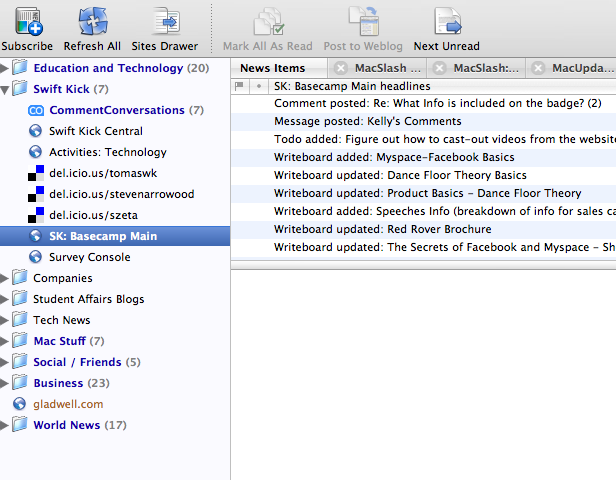I get asked a lot about offices, and when I explain that we work from all over the country people often ask how it works. It deserves its own post.
We started with almost all web-based software. It travels, it scales, it was quick to turn on and go.
Our first priority was sales (cash flow) so our first purchase was:

I had conversations with other college speakers about this purchase and they all thought we were nuts to be spending approximately $4,000 a year for this when we could spend $100 for ACT and get the “same” features.
This speaks to an SK culture point – we believe in buying ahead. It comes naturally from insisting on a bigger vision. If we only wanted to speak and were content doing it the accepted way, ACT would have been fine with us. We wanted to do more (specifically year-round follow-up to EVERY student that saw us speak) and so we knew we needed more horsepower. To be clear we had only vague notions of how this would work with Salesforce. And that’s another cultural point – we’re willing to be wrong.
Salesforce is incredibly huge and we still use only 30% of its features. We recently hired a Sforce consultant to help us take greater advantage of features in Sforce.
And like all of our web-based software, Salesforce grows. This is important. In the past, businesses custom-built their tools/processes/ and software and used it until they outgrew it. Then they had to go through the build process again. Now, when we buy into one of these companies, our tools push us. Especially when they have open-source** components to their business model. We are constantly culling and using new business ideas from the new features that come out every quarter.
Salesforce kept us on track with follow-up and sales. We could work the same contact from 1000 miles away – seamlessly. And better yet, having all of our sales work on Salesforce allowed for total transparency. Tom could see what I did and vice versa. We read each other’s e-mails, I would pick up tricks from him and he from me. Sometimes we would remind each other to be more careful with spelling or grammar. It was kind of annoying at first, like having someone reading over your shoulder, but then it just became the way we did things. We were on the same team, we had the same goal.
We talk a lot about Lego pieces around here. Meaning we have a “snap-together” toolset – if one tool becomes outdated, we swap it out with something better. Salesforce is the current sales Lego piece.
Another aspect of our business is product development. For speaking this means content. We take in huge amounts of information from the web, from books, from conversations, and we scientifically process it for easier digestion. We make presentations by grinding through the information and pulling out the valuable bits, shaping them, polishing them, and adding memorable hooks – visuals or taglines. Sharing the raw material becomes critical, especially when everyone does the same presentations. Enter:

Del.icio.us (explanation needed because our readership is diverse) is a social bookmarking site. It allows a user to create a bookmark of a website and add tags to it. This way, Tom could find a good resource and tag it “MSFB” and I would know that that bit of information was important for the MySpace Facebook Lecture.
Del.icio.us would have been fine for storage, where it becomes great for collaborative development is when it’s paired with an RSS reader. This provides us with an up to the minute feed of what everyone is interested in – so when Tom calls up and wants to talk about that new thing, if I’ve kept up with the feeds, I’ll already have the same raw info he has, and he won’t have to waste time trying to explain the background to me.
Now Steve has come on board, and one of the first things we did was to set him up on del.ico.us and an RSS Reader so that he could both read and add to the flow of new information in Swift Kick.
In practice, it looks like this:

So you can see, under the “Swift Kick” folder in my reader, I’ve got three feeds from del.icio.us – from Steve, Tom, and now Daniel** (our newest intern) and the second any one of them finds something interesting enough to save, I know about it.
You can also see there is more fun stuff in the RSS reader. I’ll get to that in Part 2. . .




